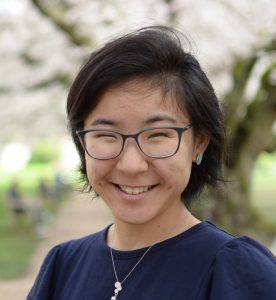 Congratulations to Momona Yamagami for passing her general exam!
Congratulations to Momona Yamagami for passing her general exam!
Momona’s proposed work titled Enhancing Device Interaction for People with Motor Impairments Using Control Theory was approved by her Ph.D. committee. Way to go Momona!
 Congratulations to Momona Yamagami for passing her general exam!
Congratulations to Momona Yamagami for passing her general exam!
Momona’s proposed work titled Enhancing Device Interaction for People with Motor Impairments Using Control Theory was approved by her Ph.D. committee. Way to go Momona!
We are proud to announce that Makoto Eyre has been offered an an internship at Blue Origin! He will be working at Blue Origin as a space architecture intern during the Winter 2020 academic quarter. See the link below for a spotlight on Makoto from earlier this year.
Please join us in congratulating Makoto and wishing him good luck!
Congratulations to Nicole Zaino for being awarded the ESMAC (European Society of Movement Analysis for Adults and Children) Best Paper Award. Nicole received this award at the 2019 ESMAC conference in Amsterdam, September 23-28, 2019 where she gave her talk: “Spasticity reduction in children with cerebral palsy is not associated with reduced energy during walking.” For more information, visit ESMAC.
Steele Lab members – Kat, Christina, Nick, and Momona – were invited to present their research about wearable sensors for stroke recovery and device control to the Seattle Young Adult Stroke Survivors (YASS). YASS is a support group for individuals who have experienced a stroke and creates a community to learn, listen, share, and more. Steele lab was one of the first research groups to come and share our work with them.
Our presentation began with background information regarding neurophysiological changes after stroke to provide insight into upper extremity functional impairments – including weakness, loss of dexterity, and abnormal tone. Wearable sensors, such as electromyography (EMG), can provide information regarding muscle function. Many of the listeners were surprised to hear that their own smartphones or watches can act as wearable sensors!
A focus of our research is detecting muscle activity early after stroke using EMG. One member recalled thinking their muscle was firing during their acute recovery but could not see any physical movement. EMG allows us to capture that type of activity and any functional changes throughout recovery, empowering patients and clinicians to track their recovery and adjust their therapy regimen. The crowd was interested in using EMG to evaluate their own muscles, identify which were firing, and guide their rehabilitation.
EMG not only helps us track recovery, but can be paired with consumer technology. Nick demonstrated how using muscle activity from the affected limb can incorporate rehabilitation into daily computer use. EMG signals can simulate pressing keys on a keyboard or moving a mouse cursor, making it easier for people with limited mobility to use technology. YASS members expressed enthusiasm about the increasing commercial availability of such devices so they can buy them and give them a try.
It was a great opportunity to connect with stroke survivors and hear their thoughts on wearable sensors. Thank you to YASS for having us come in and share our research!
Congratulations to Nicole Zaino and our colleague Mike Schwartz at Gillette Children’s Specialty Healthcare for both being nominated as finalists for the Best Presentation Award at the upcoming ESMAC Conference in Amsterdam. Their abstracts are among the top 16 submissions to the conference and the final award will be determined based upon their presentations.
Nicole will be presenting her research:
Spasticity reduction in children with cerebral palsy is not associated with reduced energy during walking
Selective dorsal rhizotomy reduces spasticity, but does it also reduce energy consumption during walking? In an analysis of over 300 children with cerebral palsy, Nicole demonstrated that although rhiztomy does reduce spasticity, it does not reduce energy consumption. These results provide further evidence that spasticity is not a main contributor to elevated energy among people with cerebral palsy. You can also learn more about this study from our recent submitted manuscript, available on bioRxiv.
Mike will be presenting his research:
The effects of walking speed and age on energy consumption in children with cerebral palsy and their typically developing peers
We know that walking energy is high among people with cerebral palsy, and that energy varies with speed and age. Using retrospective data of over 300 kids with cerebral palsy and 150 typically-developing peers, Mike used a statistical model to evaluate these speed and age effects. He found that energy decreases until 8-10 years of age for kids with CP, while it remains stable beyond age 5 for typically-developing peers. Kids with CP also have a greater elevation in energy with greater walking speeds. These results are important to help quantify and understand impacts of interventions, like surgery or assistive devices, which are often done during this time period when kids are still growing and developing.
They will both be presenting in the Optimizing Energy Cost session from 11:40-12:30 on Thursday, September 26th.
Best of luck to Nicole & Mike!